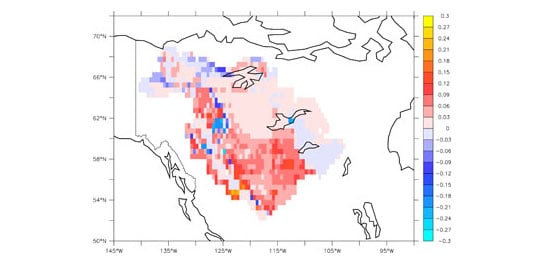Does Carbon Streghten Chemical Makeup Of Rocks

The Mackenzie River. Credit: Go/Emilie Beaulieu
The chemic weathering process of carbon dioxide in the atmosphere dissolving in rainwater to form carbonic acid, which dissolves rocks and and so flows into the oceans, stores around 0.iii billion tons of atmospheric carbon in rivers and in the oceans every year. A new study suggests that this weathering process could play a significant role in hereafter climate change models.
Chemical weathering of rocks past carbon dioxide dissolved in rainwater has never been taken into business relationship in models of future climate alter so far. However, researchers from the Laboratoire Géosciences Environnement Toulouse (CNRS/IRD/Université Toulouse Iii – Paul Sabatier), in collaboration with the Laboratoire des Sciences du Climat et de l'Environnement (CNRS/CEA/UVSQ) and the University of Bergen (Norway), take now demonstrated its sensitivity: the higher the carbon dioxide levels in the temper, the more than powerful the carbon sink, which accelerates the dissolution of rocks. The study suggests that this mechanism should be incorporated into any models of futurity climatic change. The research is published in the journal Nature Climate Change dated March 2012.
The carbon dioxide in the temper dissolves in rainwater forming carbonic acid, which, once in contact with rocks, slowly dissolves them. This atmospheric carbon is and so transported by rivers into the oceans, where it is trapped for several thousand years, before returning to the temper or alternatively being stored in marine sediments or in corals.
This chemical weathering procedure stores effectually 0.three billion tons of atmospheric carbon in rivers and in the oceans every twelvemonth: although this is considerably less than man-induced CO2 production (around eight billion tons per yr), information technology is roughly equivalent to the net commutation flux betwixt the atmosphere and the terrestrial biosphere (vegetation, soil, humus, etc) under preindustrial weather (0.4 billion tons). Despite this, chemical weathering of the continents has never been taken into account until now in models of future climate change. Admittedly, this supposedly slow flux was recognized as being one of the major carbon sinks on meg-year timescales, but considered equally insignificant on timescales of a century. All the same, measurements recently carried out past US researchers in a highly populated river basin (the Mississippi) suggested that this process could play a significant role, even on century timescales. Only this office remained hard to assess, due to the extent of agricultural activity in the bowl.

Changes in atmospheric CO2 consumption past chemical weathering in the Mackenzie River basin when atmospheric CO2 levels ascent from 355 to 560 ppmv. Simulation carried out using the B-WITCH numerical model. Credit: Beaulieu et al., 2012
In gild to eliminate, as much as possible, the impacts related to state apply change and isolate the function of the climate in the chemical weathering of rocks, the researchers chose to study one of the biggest Arctic watersheds, the Mackenzie River basin, located in north-westward Canada. They used a kickoff numerical model to estimate future climatic change, doubling the corporeality of CO2 in the temper (a level likely to be reached by 2100). Under these conditions, temperatures increased by 1.4 – iii °C and average precipitation past seven% in the Mackenzie River bowl. This predicted climate was then inputted into a second model capable of simulating the productivity of the biosphere and soil hydrology, making it possible to calculate the chemic dissolution of minerals.
The scientists found that when the amount of atmospheric CO2 rose from 355 ppmv (at the finish of the twentieth century) to 560 ppmv (by 2100), the Mackenzie River basin responded by capturing fifty% more atmospheric CO2 through chemical weathering. twoscore% of this increase is directly linked to climatic change (college temperatures and rainfall advance mineral dissolution), while the remaining 60% is put downwards to irresolute vegetation activity: higher atmospheric CO2 levels reduce evapotranspiration in plants, which intensifies circulation of water in soils. The increased circulation speeds up chemical weathering of rocks.
This research has thus demonstrated the high sensitivity of continental chemical weathering to human being-induced climate change. Atmospheric CO2 consumption through this process could rise by 50% past 2100. The sensitivity of this flux to climate change would then be equivalent to the flux related to the terrestrial biosphere. In the Mackenzie River basin, where rainfall will tend to increase, streams and rivers will capture more carbon as the climate becomes warmer and atmospheric CO2 levels rise. Will this trend be the aforementioned in regions that go more arid? Given its high sensitivity, will continental chemic weathering allow excess CO2 to be absorbed, leading to a more rapid render to equilibrium than predicted? Many questions remain unanswered, especially the sensitivity of this procedure to human being activity (changes in state utilize, air pollution, etc). All the same one affair is sure: chemical weathering volition now need to be incorporated into each and every model of future terrestrial climate change.
This research was funded in detail by CNRS's EC2CO program.
Images: GET/Emilie Beaulieu; Beaulieu et al.
High sensitivity of the CO2 sink by continental weathering to the futurity climate change. Emilie Beaulieu, Yves Goddéris, Yannick Donnadieu, David Labat, Caroline Roelandt. Nature Climate change, March 2012 (DOI : 10.1038/NCLIMATE1419).
Source: https://scitechdaily.com/the-role-of-climate-change-in-chemical-weathering-of-rocks/
Posted by: combswhearclas.blogspot.com

0 Response to "Does Carbon Streghten Chemical Makeup Of Rocks"
Post a Comment